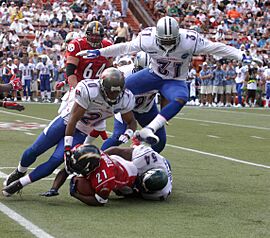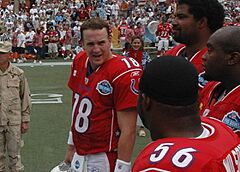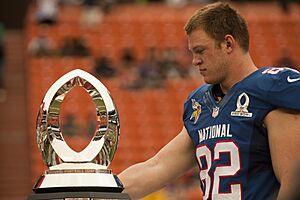Pro Bowl facts for kids
Quick facts for kids Pro BowlNational Football League All-Star Game (1939–1942)
Pro Bowl (1951–2022) Pro Bowl Games (2023–present) |
|
|---|---|
 |
|
| Frequency | Annual |
| Location(s) | Varies (see text) |
| Inaugurated | 1939 |
| Previous event | February 2, 2025 (Camping World Stadium, Orlando, Florida) |
| Participants | American Football Conference National Football Conference |
| Organized by | National Football League |
The Pro Bowl Games is a yearly event held by the National Football League (NFL). It brings together the best football players from the league.
The way the Pro Bowl is played has changed a lot over the years. From 1939 to 1942, it was a game where the NFL champion team played against a team of all-stars. The first official Pro Bowl was in January 1951. It featured top players from the Eastern Conference against those from the Western Conference.
After the NFL joined with the American Football League (AFL) in 1970, the game was called the AFC–NFC Pro Bowl. This meant the best players from the American Football Conference (AFC) played against those from the National Football Conference (NFC).
From 2014 to 2016, the NFL tried a different idea. Instead of AFC vs. NFC, two famous former players picked the teams. These players were chosen in a special TV event before the game.
For a long time, some people thought the Pro Bowl wasn't very exciting. They felt the players didn't try as hard to avoid injuries. One report even said players in the 2012 game were "hitting each other as though they were having a pillow fight".
However, being chosen for the Pro Bowl is a huge honor for any player. It shows they are one of the best in the league. In September 2022, the NFL announced a big change. Starting in 2023, the main Pro Bowl game would be a non-contact flag football game. The whole week would be called the "Pro Bowl Games" and include other fun challenges.
Unlike other major sports, the NFL's all-star game is held near the end of the season. Before 2010, it was usually played after the Super Bowl. From 2010 to 2022, it was played the Sunday before the Super Bowl. Since 2023, it's played on the first Thursday and Sunday of February, still before the Super Bowl. This means players from the two teams playing in the Super Bowl don't get to play in the Pro Bowl.
Contents
History of the Pro Bowl Games
The very first "Pro All-Star Game" was played on January 15, 1939, in Los Angeles. It featured the best players from the 1938 season. This early all-star game was played a few more times until 1942. It stopped because of travel rules during World War II. In these early games, the league champion team played against an all-star team. The champion team won most of these games.
The idea of an all-star game came back in June 1950. It was then called the "Pro Bowl." This time, it was decided that all-star teams from each of the league's two conferences would play. This was different from the old format where the league champion played against all-stars.
The first 21 Pro Bowl games (from 1951 to 1972) were all played in Los Angeles. After that, the game moved around to different cities for seven years. Then, it found a home in Aloha Stadium in Halawa, Hawaii, for 30 years, from 1980 to 2009.
The 2010 Pro Bowl was played in Miami, Florida. This was the first time the Pro Bowl was held before the Super Bowl. This change was made because fewer people were watching the game when it was played after the Super Bowl. The Pro Bowl then returned to Hawaii in 2011 and stayed there for three more years, still played the week before the Super Bowl.
The 2012 game received some complaints because players didn't seem to be playing very hard. On October 24, 2012, NFL Commissioner Roger Goodell even said he might stop the Pro Bowl if players didn't play more competitively.
To keep the game going, the NFL Players Association worked with the league. They made some new rules for the 2014 game. One big change was that teams would no longer be AFC vs. NFC. Instead, famous former players would pick the teams in a "fantasy draft" style. For the 2014 game, Jerry Rice and Deion Sanders were the honorary captains who picked the teams.
The 2015 Pro Bowl was played in Arizona. The game returned to Hawaii in 2016, and that was the last time the "unconferenced" format was used.
For 2017, the league thought about holding the game in Brazil. But instead, it was held at Camping World Stadium in Orlando, Florida. The NFL also decided to bring back the old AFC vs. NFC format.
Since the 2017 Pro Bowl, the NFL has also added fun side events. These are called the Pro Bowl Skills Showdown. They include competitions like passing challenges and dodgeball games among the players.
The 2021 Pro Bowl game was canceled because of the COVID-19 pandemic. The city of Las Vegas, which was supposed to host, got to host the 2022 Pro Bowl instead. Even though the game was canceled, players were still voted onto the Pro Bowl roster.
In May 2022, Commissioner Roger Goodell again wondered about the future of the Pro Bowl. He felt a new way to celebrate the players was needed. On September 26, 2022, it was announced that the 2023 event would be "The Pro Bowl Games." This new format replaced the main tackle football game with a flag football game.
How Players Are Chosen

Players are chosen for the Pro Bowl by three groups: the coaches, the players themselves, and the fans. Each group's votes count for one-third of the total. Fans can vote for their favorite players on NFL.com.
If a player who is chosen can't play because of an injury, or if they are playing in the Super Bowl, another player is picked to take their place. Since 2010, players from the two teams that make it to the Super Bowl do not play in the Pro Bowl. However, they are still considered "Pro Bowlers" for that year.
From 2014 to 2016, the Pro Bowl used a "fantasy draft" style. Two team captains picked the players for their teams.
Coaching the Pro Bowl Teams
The coaches for the Pro Bowl teams are usually chosen from the teams that had great seasons but didn't make it to the Super Bowl.
When the Pro Bowl was moved to the week before the Super Bowl, the coaches were chosen from the teams that lost in the Divisional Playoff Round and had the best regular season records.
Since the Pro Bowl changed to the Pro Bowl Games format in 2023, famous brothers Peyton Manning and Eli Manning have been the "honorary" coaches. Peyton coaches the AFC team, and Eli coaches the NFC team. Both brothers played their entire NFL careers in their respective conferences.
Awards and Player Pay
In the past, different awards were given out, like Player of the Game or Outstanding Offensive/Defensive Player. Since 2008, the main award has been the Most Valuable Player (MVP).
Players also get paid for playing in the game. The players on the winning team receive more money than those on the losing team. Here's how much players earned in recent years:
| Years | Winners | Losers |
|---|---|---|
| 2022–23 | $84,000 | $42,000 |
| 2024 | $88,000 | $44,000 |
| 2025 | $92,000 | $46,000 |
Special Rules for the Pro Bowl
The Pro Bowl has some different rules compared to regular NFL games. These rules are made to make the game safer and more fun to watch.
- Players usually agree to avoid hard tackles. Ball carriers often give up or run out of bounds to prevent strong hits. It's almost like a two-hand touch football game.
- Offensive teams cannot make fake movements or shift players around before the snap.
- Offensive teams must have a running back and a tight end in all plays.
- Teams can have up to three receivers on one side of the field.
- It's okay to throw the ball away to avoid a sack (called intentional grounding).
- Defensive players cannot rush the quarterback right away.
- More than one forward pass is allowed on the same play.
- Defensive teams must use a specific formation (a 4-3 defense).
- Defensive players cannot blitz (rush the quarterback from far away).
- No hitting players from behind or below the waist.
- No rushing the punter or kicker.
- There are no kickoffs. Teams start on their own 25-yard line after a score or at the start of each half.
- Punt returns are not allowed; the ball is automatically considered a fair catch.
- If a team wants to try to keep the ball after a score (like an onside kick in a regular game), they can run one play from their own 25-yard line. If they gain 15 yards, they keep the ball.
- The play clock (time to start a play) is 35 seconds.
- There are two-minute warnings in all quarters and overtime.
- The game clock stops on incomplete passes only in the last two minutes of a half or overtime.
- Replay reviews are allowed, just like in regular games.
- Each team has 44 players on its roster.
- If the game is tied after regular time, they play multiple 15-minute overtime periods until a winner is decided. The Pro Bowl cannot end in a tie.
In the Pro Bowl Games format (since 2023), the AFC and NFC teams earn points from different skills competitions throughout the week. These points are added to the score of the main flag football game. The team with the most points after the flag football game wins the Pro Bowl Games.
The flag football games are played on a smaller field (50 yards long by 28 yards wide) with seven players per team. Each game has two 10-minute halves. Teams can try for 1 or 2 points after a touchdown. In overtime, each team gets one chance to score. If it's still tied, the next team to score wins.
Pro Bowl Uniforms

Since players come from many different NFL teams, they can't wear their regular team uniforms. That would be too confusing! However, players do wear their own team's helmet.
In the past, the AFC team wore solid red jerseys and pants, and the NFC team wore solid blue jerseys and white pants. For a while, players wore special red or white helmets with a big "A" or "N" on them. But since 1979, players have worn their own team helmets.
Sometimes, players with the same jersey number can both play in the Pro Bowl. In the 2008 Pro Bowl, three players from the Washington Redskins all wore the number 21. They did this to honor their teammate Sean Taylor, who had passed away.
In 2014, Nike designed new uniforms that were very different. They used bright orange and volt green colors instead of the traditional red, white, and blue. These new uniforms got mixed reactions from fans.
Since 2017, when the AFC vs. NFC format returned, the uniforms have been mostly solid colors. The AFC wears red, and the NFC wears blue, similar to the NFL's "Color Rush" uniforms.
With the switch to the Pro Bowl Games in 2023, players no longer wear full football uniforms with helmets and pads. They wear red or blue shirts with gray shorts or pants. Some players also wear caps.
Stadiums that have hosted the Pro Bowl
- Wrigley Field (1939)
- Gilmore Stadium (January and December 1940)
- Polo Grounds (January 1942)
- Shibe Park (December 1942)
- Los Angeles Memorial Coliseum (1951–1972, 1979)
- Texas Stadium (1973)
- Arrowhead Stadium (1974)
- Miami Orange Bowl (1975)
- Louisiana Superdome (1976)
- Kingdome (1977)
- Tampa Stadium (1978)
- Aloha Stadium (1980–2009, 2011–2014, 2016)
- Sun Life Stadium (2010)
- University of Phoenix Stadium (2015)
- Camping World Stadium (2017–2020, 2024–Present)
- Allegiant Stadium (2022–2023)
Players with Most Pro Bowl Invitations
Being invited to the Pro Bowl many times is a sign of a truly great player. As of the 2024 Pro Bowl Games, 29 players have been invited at least 11 times. Most of these players are now in the Pro Football Hall of Fame.
Tom Brady, a famous quarterback, holds the record with 15 Pro Bowl invitations. Among players still playing, offensive lineman Trent Williams has the most invitations with 11.
| Pro Bowls |
Player | Pos | Selection years |
|---|---|---|---|
| 15 | Tom Brady | QB | 2001, 2004, 2005, 2007, 2009–2018, 2021 |
| 14 | Tony Gonzalez | TE | 1999–2008, 2010–2013 |
| Peyton Manning | QB | 1999, 2000, 2002–2010, 2012–2014 | |
| Bruce Matthews | G | 1988–2001 | |
| Merlin Olsen | DT | 1962–1975 | |
| 13 | Drew Brees | QB | 2004, 2006, 2008–2014, 2016–2019 |
| Ray Lewis | LB | 1997–2001, 2003, 2004, 2006–2011 | |
| Jerry Rice | WR | 1986–1996, 1998, 2002 | |
| Reggie White | DE | 1986–1998 | |
| 12 | Champ Bailey | CB | 2000–2007, 2009–2012 |
| Ken Houston | S | 1968–1979 | |
| Randall McDaniel | G | 1989–2000 | |
| Jim Otto | C | 1961–1972 | |
| Junior Seau | LB | 1991–2002 | |
| Will Shields | G | 1995–2006 | |
| 11 | Larry Allen | G | 1995–2001, 2003–2006 |
| Derrick Brooks | LB | 1997–2006, 2008 | |
| Brett Favre | QB | 1992, 1993, 1995–1997, 2001–2003, 2007–2009 | |
| Larry Fitzgerald | WR | 2005, 2007–2013, 2015–2017 | |
| Bob Lilly | DT | 1962, 1964–1973 | |
| Tom Mack | G | 1967–1975, 1977, 1978 | |
| Gino Marchetti | DE | 1954–1964 | |
| Anthony Muñoz | OT | 1981–1991 | |
| Jonathan Ogden | OT | 1997–2007 | |
| Willie Roaf | OT | 1994–2000, 2002–2005 | |
| Bruce Smith | DE | 1987–1990, 1992–1998 | |
| Trent Williams | OT | 2012–2018, 2020−2023 | |
| Jason Witten | TE | 2004–2010, 2012–2014, 2017 | |
| Rod Woodson | CB | 1989–1994, 1996, 1999–2002 |
Watching the Pro Bowl on TV
The Pro Bowl has been shown on many different TV networks over the years. From 1975 to 1987, it was part of Monday Night Football on ABC. Then, ESPN took over from 1988 to 1994. It went back to ABC from 1995 to 2003.
From 2007 to 2014, the same network that showed the Super Bowl also showed the Pro Bowl. Since 2015, ESPN has had the main rights to broadcast the Pro Bowl. In 2018, it also started being shown on ABC at the same time. Disney XD joined the broadcast in 2019, making it easy for kids to watch. These joint broadcasts continued through 2022.
A famous football announcer, John Madden, never broadcasted the Pro Bowl because he didn't like flying.
The Pro Bowl also has a charity bowling tournament during the week. NFL players can join, and the winners get to donate money to their favorite charities.
Most Watched Pro Bowls (Since 2000)
Here are some of the most watched Pro Bowl games since the year 2000:
| Rank | Game | Date | Matchup | Network | Viewers (millions) | TV rating | Location | |||
|---|---|---|---|---|---|---|---|---|---|---|
| 1 | 2011 Pro Bowl | January 29, 2011 | AFC | 41 | NFC | 55 | Fox | 13.4 | 7.7 | Aloha Stadium, Honolulu, HI |
| 2 | 2000 Pro Bowl | February 6, 2000 | AFC | 31 | NFC | 51 | ABC | 13.2 | 8.6 | |
| 3 | 2012 Pro Bowl | January 29, 2012 | NFC | 41 | AFC | 59 | NBC | 12.5 | 7.3 | |
| 4 | 2010 Pro Bowl | January 31, 2010 | AFC | 41 | NFC | 34 | ESPN | 12.3 | 7.1 | Sun Life Stadium, Miami Gardens, FL |
| 5 | 2013 Pro Bowl | January 27, 2013 | AFC | 35 | NFC | 62 | NBC | 12.2 | 7.1 | Aloha Stadium, Honolulu, HI |
| 6 | 2014 Pro Bowl | January 26, 2014 | Team Rice | 22 | Team Sanders | 21 | 11.4 | 6.6 | ||
| 7 | 2008 Pro Bowl | February 10, 2008 | AFC | 30 | NFC | 42 | Fox | 10.0 | 6.3 | |
| 8 | 2003 Pro Bowl | February 2, 2003 | NFC | 23 | AFC | 45 | ABC | 9.1 | 5.9 | |
| 9 | 2009 Pro Bowl | February 8, 2009 | NFC | 30 | AFC | 21 | NBC | 8.8 | 5.4 | |
| 10 | 2015 Pro Bowl | January 25, 2015 | Team Irvin | 32 | Team Carter | 28 | ESPN | 8.8 | 5.1 | University of Phoenix Stadium, Glendale, AZ |
See also
 In Spanish: Pro Bowl para niños
In Spanish: Pro Bowl para niños
- American Football League All-Star games
- All-America Football Conference All-Star Game
- Chicago College All-Star Game – a series played between an NFL team and a college all-star team
- NFL Pro Bowl records


